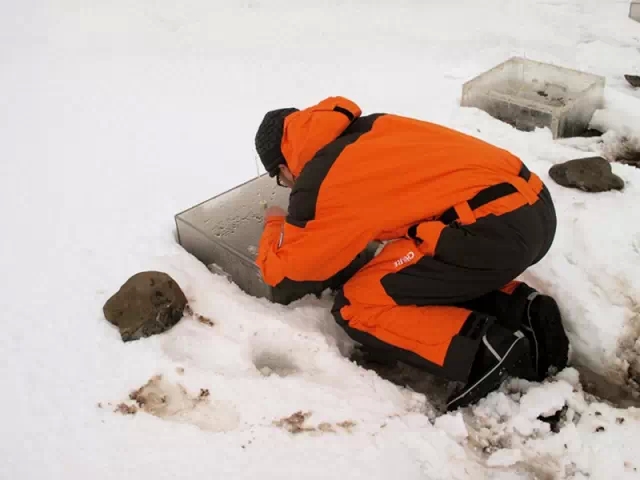

4. Scientists stick to their posts on the continent of Antarctic
The scientists suffer from cold weather as the annual average temperature is minus 25 degrees Celsius. The period of polar night from mid-May to mid-July might trigger depression on the staff at the Antarctic Zhongshan Station. However, the scientists still choose to hold fast to their positions during that period. After the end of the polar night, they will go to Tian'E Mound and take photos there to celebrate.

The former 1st building at the Antarctic Great Wall Station.(People's Daily/Wang Hailin)

Scientists carrying out research work.(Photo contributed to People's Daily)

Scientists carrying out research work.(Photo contributed to People's Daily)
5. A glimpse of Antarctic research programs by scientists
Here, Wang will introduce you to several research projects launched by scientists.

A scientist taking a sample.(People's Daily /Wang Hailin)
At the end of January 2015, using drilling methods, China's 31th Antarctic Expedition went to Dome A at an altitude of 4093 meters and took an ice core from a depth of 172 meters. This successful drilling of ice cores marked the launch of China's national research project on deep core drilling after six years of preparation. The scientists plan to obtain cores from a depth of 3000 meters within a period of four or five years.

Researchers in the open air(Photo contributed to People's Daily)
The deep ice cores are composed of layers of sediments of different ages. Gas bubbles trapped in the ice contain chemical clues that reveal temperature variations all through the past millions of years, and indicate potential climatic changes in the future.
6. Analysis on penguin excrement

Penguins on the Antarctic Continent.(People's Daily/Wang Hailin)
Ardley Island is home to penguins. As the tide ebbs, the scientists at the Antarctic Great Wall Station collect the penguin excrement.
Wang Xumin, a scientist at Chinese Academy of Sciences, focuses on the analysis on the penguin excrement lying on the continent of Antarctic for hundreds of thousands years or even millions of years. As the penguin excrement abounds in microbes, scientists can isolate bacteria in the excrement and trace the evolutionary changes of living creatures.
Genomic research is also a focus of study for foreign researchers. The scientists at the Chile's Antarctic research institute conduct research on shellfish in their simple laboratory.

Scientists on an experiment.(People's Daily/Wang Hailin)

Scientists on an experiment.(People's Daily/Wang Hailin)
7. A rock sample unveils the crustal movement

A scientist of the Antarctic scientific expedition, Gao Liang has collected a cylinder-shaped rock sample with diameter of 10 centimeters and height of 2.5 centimeters. In the lab, he identifies the direction of remnant magnetic ores present in the rock sample by using a superconducting magnetometer. With the information, the algorithm tells the scientists the paleolatitude of the region and the drifts of region since the formation of the rock sample. Therefore, scientists can trace the movements of the continent of Antarctic.(Photo contributed to People's Daily)
8.The watchword of the Antarctic Great Wall Station

 |
Day|Week

 Tsinghua junior makes over 10,000 yuan a day by selling alumnae's used quilts
Tsinghua junior makes over 10,000 yuan a day by selling alumnae's used quilts Graduation photos of students from Zhongnan University
Graduation photos of students from Zhongnan University A school with only one teacher in deep mountains
A school with only one teacher in deep mountains Glimpse of cultural heritage "Xilankapu"
Glimpse of cultural heritage "Xilankapu" Homemade cured hams in SW China
Homemade cured hams in SW China Breathtaking buildings of W. Sichuan Plateau
Breathtaking buildings of W. Sichuan Plateau Graduation photos of "legal beauties"
Graduation photos of "legal beauties" Top 10 most expensive restaurants in Beijing in 2015
Top 10 most expensive restaurants in Beijing in 2015